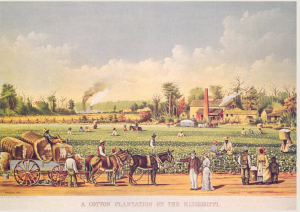
(“A Cotton Plantation on the Mississippi,” Currier & Ives, 1884. (Library of Congress))
As soon as the Civil War ended however, the Southern states and their leaders began changing their narrative. Slavery became something that had been good to everyone. Southern publications and politicians promoted the idea of an economic institution of a paternalistic-fostering nature. Racial superiority remained an element within Southern ideology, but it was no longer a message about an inferior race that deserved subjugation and eternal servitude. The new message was about how the superior white race was caring and nurturing for the other less endowed race. The whites offered the means and environment for blacks to prosper and expand their abilities under their watchful patronage. The superior race allowed the inferior race to achieve much more than they otherwise could, since they lacked direction or the ability to function effectively in modern society. Free from the burden of labor, whites could pursue cultural endeavors which would help in the advancement of everyone. Reading from a modern perspective, the reader would be well within their right to harbor a feeling of disbelief at the lunacy and outrageousness of these claims. Though insane and outrageous these claims were, even for the time, the message of the Southern leaders took hold and continued to expand into the American population.
